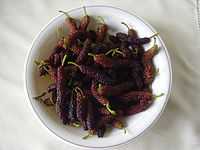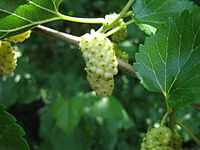Morus (plant)
| Mulberry | |
|---|---|
 | |
| Morus nigra | |
| Scientific classification | |
| Kingdom: | Plantae |
| (unranked): | Angiosperms |
| (unranked): | Eudicots |
| (unranked): | Rosids |
| Order: | Rosales |
| Family: | Moraceae |
| Tribe: | Moreae[1] |
| Genus: | Morus L. |
| Species | |
|
See text. | |
Morus, a genus of flowering plants in the family Moraceae, comprises 10–16 species of deciduous trees commonly known as mulberries growing wild and under cultivation in many temperate world regions.[2]
The closely related genus Broussonetia is also commonly known as mulberry, notably the Paper Mulberry, Broussonetia papyrifera. Mulberries are swift-growing when young, but soon become slow-growing and rarely exceed 10–15 m (33–49 ft) tall. The leaves are alternately arranged, simple, often lobed, more often lobed on juvenile shoots than on mature trees, and serrated on the margin.
Depending on the species, they can be monoecious or dioecious.[3]
The mulberry fruit is a multiple fruit, 2–3 cm (0.79–1.18 in) long. Immature fruits are white, green, or pale yellow. In most species, the fruits turn pink and then red while ripening, then dark purple or black, and have a sweet flavor when fully ripe. The fruits of the white-fruited cultivar are white when ripe; the fruit in this cultivar is also sweet but has a very mild flavor compared with the darker variety.
Species


The taxonomy of Morus is complex and disputed. Over 150 species names have been published, and although differing sources may cite different selections of accepted names, only 10–16 are generally cited as being accepted by the vast majority of botanical authorities. Morus classification is even further complicated by widespread hybridisation, wherein the hybrids are fertile.
The following species are generally accepted:
- Morus alba L. – White Mulberry (E Asia)
- Morus australis Poir. – Chinese Mulberry (SE Asia)
- Morus celtidifolia Kunth (Mexico)
- Morus insignis (S America)
- Morus mesozygia Stapf – African Mulberry (S and C Africa)
- Morus microphylla – Texas Mulberry (Mexico, Texas (USA))
- Morus nigra L. – Black Mulberry (SW Asia)
- Morus rubra L. – Red Mulberry (E N America)
The following, all from eastern and southern Asia, are additionally accepted by one or more taxonomic lists or studies; synonymy, as given by other lists or studies, is indicated in square brackets:
- Morus atropurpurea [M. alba var. alba]
- Morus bombycis [M. australis]
- Morus cathayana
- Morus indica [M. alba]
- Morus japonica [M. alba]
- Morus kagayamae [M. australis]
- Morus laevigata [M. alba var. laevigata; M. macroura]
- Morus latifolia [M. alba]
- Morus liboensis
- Morus macroura [M. alba var. laevigata]
- Morus mongolica [M. alba var. mongolica]
- Morus multicaulis [M. alba var. multicaulis]
- Morus notabilis
- Morus rotundiloba
- Morus serrata [M. alba var. serrata], Himalayan mulberry
- Morus tillaefolia
- Morus trilobata [M. australis var. trilobata]
- Morus wittiorum
Uses and cultivation

The ripe fruit is edible and is widely used in pies, tarts, wines, cordials and tea. The fruit of the black mulberry, native to southwest Asia, and the red mulberry, native to eastern North America, have the strongest flavor, described as 'like fireworks in your mouth'.[4]
The fruit of the white mulberry, an east Asian species which is extensively naturalized in urban regions of eastern North America, has a different flavor, sometimes characterized as refreshing and a little tart, with a bit of gumminess to it and a hint of vanilla.[5][6] In North America the white mulberry is considered an invasive exotic and has taken over extensive tracts from native plant species, including the red mulberry.[7] The mature plant contains significant amounts of resveratrol, particularly in stem bark.[8] The fruit and leaves are sold in various forms as nutritional supplements. Unripe fruit and green parts of the plant have a white sap that may be toxic, stimulating, or mildly hallucinogenic.[9]
Black, red, and white mulberry are widespread in southern Europe, the Middle East, northern Africa and Indian Subcontinent where the tree and the fruit have names under regional dialects. Jams and sherbets are often made from the fruit in this region. Black mulberry was imported to Britain in the 17th century in the hope that it would be useful in the cultivation of silkworms. It was much used in folk medicine, especially in the treatment of ringworm. Mulberries are also widespread in Greece, particularly in the Peloponnese, which in the Middle Ages was known as Morea (Greek: Μωριάς, Morias), deriving from the Greek word for the tree (Greek: Μουριά, Μouria).
Mulberries can be grown from seed, and this is often advised as seedling-grown trees are generally of better shape and health, but they are most often planted from large cuttings which root readily. The mulberry plants which are allowed to grow tall with a crown height of 5–6 feet from ground level and a stem girth of 4–5 inches or more is called tree mulberry. They are specially raised with the help of well-grown saplings 8–10 months old of any of the varieties recommended for rain-fed areas like S-13 (for red loamy soil) or S-34 (black cotton soil) which are tolerant to drought or soil-moisture stress conditions. Usually, the plantation is raised and in block formation with a spacing of 6 feet x 6 feet, or 8 feet x 8 feet, as plant to plant and row to row distance. The plants are usually pruned once a year during the monsoon season (July – August) to a height of 5–6 feet and allowed to grow with a maximum of 8–10 shoots at the crown. The leaves are harvested 3–4 times a year by a leaf picking method under rain-fed or semi-arid conditions, depending on the monsoon.
The tree branches pruned during the fall season (after the leaves have fallen) are cut and used to make durable baskets supporting agriculture and animal husbandry.
Some North American cities have banned the planting of mulberries because of the large amounts of pollen they produce, posing a potential health hazard for some pollen allergy sufferers.[10]
Silk industry

Mulberry leaves, particularly those of the white mulberry, are ecologically important as the sole food source of the silkworm (Bombyx mori, named after the mulberry genus Morus), the pupa/cocoon which is used to make silk.[11][12] Other Lepidoptera larvae – which include the common emerald, the lime hawk-moth, and the sycamore moth – also sometimes eat the plant.
Anthocyanins from mulberry fruit
Anthocyanins are pigments which hold potential use as dietary modulators of mechanisms for various diseases[13][14] and as natural food colorants. Due to increasing demand for natural food colorants, their significance in the food industry is increasing. Anthocyanins are responsible for the attractive colors of fresh plant foods, producing colors such as orange, red, purple, black, and blue. They are water-soluble and easily extractable.
A cheap and industrially feasible method to purify anthocyanins from mulberry fruit which could be used as a fabric tanning agent or food colorant of high color value (of above 100) has been established. Scientists found that, of 31 Chinese mulberry cultivars tested, the total anthocyanin yield varied from 148 mg to 2725 mg per liter of fruit juice.[15] It was also found that total sugars, total acids, and vitamins remained intact in the residual juice after removal of the anthocyanins, so the residual juice could be fermented to produce products such as juice, wine, and sauce.
Anthocyanin content depends on climate and area of cultivation and is particularly high in sunny climates.[16] This finding holds promise for tropical sericulture countries to profit from industrial anthocyanin production from mulberry through anthocyanin recovery.
This offers a challenging task to the mulberry germplasm resources for
- exploration and collection of fruit yielding mulberry species;
- their characterization, cataloging, and evaluation for anthocyanin content by using traditional as well as modern means and biotechnology tools;
- developing an information system about these cultivars or varieties;
- training and global coordination of genetic stocks;
- evolving suitable breeding strategies to improve the anthocyanin content in potential breeds by collaboration with various research stations in the field of sericulture, plant genetics, and breeding, biotechnology and pharmacology.
In popular culture

The nursery rhyme Here We Go Round the Mulberry Bush uses the tree in the refrain, as do some contemporary American versions of the nursery rhyme Pop Goes the Weasel. Vincent van Gogh featured the mulberry tree in some of his paintings, notably "Mulberry Tree."[17]
The Roman mythological tale of Pyramus and Thisbe provides a story of the mulberry fruit's color. According to the tale, after the two lovers die tragically, the gods listen to Thisbe's lament and forever change the color of the mulberry fruits into their red stained color to honor the forbidden love.
Gallery
-
Clusters (inflorescences) of unopened female flower buds.
-

Morus nigra male flowers.
-

Female flowers clusters.
References
- ↑ "Morus L.". Germplasm Resources Information Network. United States Department of Agriculture. 2009-01-16. Retrieved 2009-03-11.
- ↑ Suttie JM. "Morus alba L.". Plant Production and Protection. Food and Agricultural Organization of the United Nations. Retrieved 20 October 2012.
- ↑ "Red Mulberry". Northeastern Area State & Private Forestry - USDA Forest Service. Retrieved 1 November 2011.
- ↑ The Cloudforest Gardener
- ↑ The Cloudforest Gardener
- ↑ Mulberry
- ↑ Boning, Charles R. (2006). Florida's Best Fruiting Plants: Native and Exotic Trees, Shrubs, and Vines. Sarasota, Florida: Pineapple Press, Inc. p. 153.
- ↑ Cui XQ, Wang HQ, Liu C, Chen RY (July 2008). "Study of anti-oxidant phenolic compounds from stem barks of Morus yunanensis" [Study of anti-oxidant phenolic compounds from stem barks of Morus yunanensis]. Zhongguo Zhong Yao Za Zhi (in Chinese) 33 (13): 1569–72. PMID 18837317.
- ↑ "White mulberry, Morus alba". Ohio Perennial and Biennial Weed Guide. The Ohio State University. Retrieved 20 October 2012.
- ↑ "Toronto's Messy Mulberry Sidewalks.". Fuel Ghoul. Retrieved 31 October 2011.
- ↑ Ombrello, T PhD. "The mulberry tree and its silkworm connection". Department of Biology, Union County College, Cranford, NJ. Retrieved 20 October 2012.
- ↑ "Mulberry silk". Central Silk Board, Ministry of Textiles - Govt of India. 2012. Retrieved 20 October 2012.
- ↑ Wrolstad RE. The possible health benefits of anthocyanin pigments and polyphenolics, Linus Pauling Institute, Oregon State University, 2001
- ↑ Hou DX (March 2003). "Potential mechanisms of cancer chemoprevention by anthocyanins". Current Molecular Medicine 3 (2): 149–59. doi:10.2174/1566524033361555. PMID 12630561.
- ↑ Liu X, Xiao G, Chen W, Xu Y, Wu J (2004). "Quantification and Purification of Mulberry Anthocyanins with Macroporous Resins". Journal of Biomedicine & Biotechnology 2004 (5): 326–331. doi:10.1155/S1110724304403052. PMC 1082888. PMID 15577197.
- ↑ Matus JT, Loyola R, Vega A, et al. (2009). "Post-veraison sunlight exposure induces MYB-mediated transcriptional regulation of anthocyanin and flavonol synthesis in berry skins of Vitis vinifera". Journal of Experimental Botany 60 (3): 853–67. doi:10.1093/jxb/ern336. PMC 2652055. PMID 19129169.
- ↑ van Gogh V (1889). "Mulberry Tree". van Gogh Collection. Norton Simon Museum, Pasadena, California. Retrieved 20 October 2012.
External links
| Wikispecies has information related to: Morus (Moraceae) |
| Wikimedia Commons has media related to Morus. |
| Wikisource has the text of The New Student's Reference Work article Mulberry. |
- Flora of China: Morus
- Flora of North America: Morus
- University of Melbourne: Sorting Morus names
- Propagation (growing) by vegetative method
- Propagation (growing) by seed method
- 300 year old Japanese mulberry
- Central Sericultural Germplasm Resources Centre Ministry of Textiles Government of India
- Replant a mulberry tree
